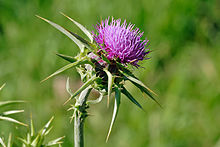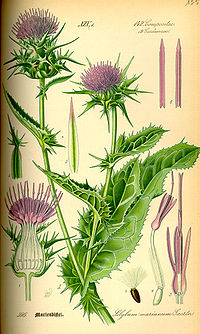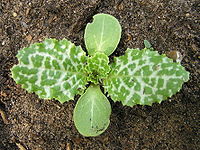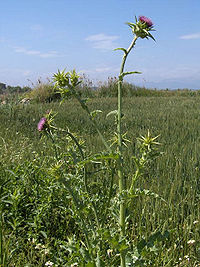- Silybum marianum
-
"Blessed milk thistle" redirects here. For "blessed thistle", see Cnicus.
Milk thistle 
Scientific classification Kingdom: Plantae (unranked): Angiosperms (unranked): Eudicots (unranked): Asterids Order: Asterales Family: Asteraceae Tribe: Cynareae Genus: Silybum Species: S. marianum Binomial name Silybum marianum Silybum marianum, colloquially identified as Carduus marianus, known as milk thistle, is an annual or biannual plant of the Asteraceae family. This fairly typical thistle has red to purple flowers and shiny pale green leaves with white veins. Originally a native of Southern Europe through to Asia, it is now found throughout the world. The medicinal parts of the plant are the ripe seeds.
Common names for this species include blessed milk thistle, Marian Thistle, Mary Thistle, Saint Mary's Thistle, Mediterranean Milk Thistle and Variegated Thistle.
Contents
Description
It grows 40 to 100 cm tall. The stem is grooved and more or less cottony.
The leaves are oblong to lanceolate. They are either lobate or pinnate, with spiny edges. They are hairless, shiny green, with milk-white veins.
The flower heads are 4 to 5 cm long and wide, of red-purple colour. They flower from June to August.
The bracts are hairless, with triangular, spine-edged appendages, tipped with a stout yellow spine.
The achenes are black, with a simple long white pappus, surrounded by a yellow basal ring.[1]
Medicinal Uses
In herbalism, it is used in cases of liver diseases (cirrhosis, jaundice and hepatitis), gallbladder disease, and is claimed to protect the liver against poisons. Silibinin (syn. silybin, sylimarin I) is a hepatoprotective (antihepatotoxic), antioxidant (radical-scavenging agent), thus stabilizing and protecting the membrane lipids of the hepatocytes (liver cells). Silicristin inhibits the enzymes peroxidase and lipoxygenase. Silidianin is a plant growth regulator. A 2000 study of such claims by the AHRQ concluded that "clinical efficacy of milk thistle is not clearly established". However a more recent study did show activity against liver cancers. A 2005 Cochrane Review considered thirteen randomised clinical trials which assessed milk thistle in 915 patients with alcoholic and/or hepatitis B or C virus liver diseases. They question the beneficial effects of milk thistle for patients with alcoholic and/or hepatitis B or C virus liver diseases and highlight the lack of high-quality evidence to support this intervention. Cochrane concluded more good quality randomised clinical trials on milk thistle versus placebo are needed.
Its potent extract is used in medicine under the name silymarin (a flavonolignane complex consisting of silibinin A and B/silybin/silymarin I, isosilibinin A and B, silicristin/silymarin II, silidianin). Silibinin is used against poisoning by amanitas, such as the Death Cap (Amanita phalloides)[2] as well as in cerebral edema and acute hepatitis therapy.
Mary thistle has been grown as a medicinal plant in monasterial gardens since ancient times.The seed is the part of the plant used medicinally.
Silybum marianum extract has antifungal effects, it prevents the growth of dermatophytes more than saprophytes fungi.[3]
One pilot study shows milk thistle may be as effective as fluoxetine in treatment of obsessive-compulsive disorder.[4]
Where it grows
Possibly native near the coast of south east England.It has been widely introduced outside its natural range, for example into Iran, North America, Australia, and New Zealand where it is considered an invasive weed. Cultivated fields for the production of raw-material for the pharmaceutical industry exists on a larger scale in Austria (Region Waldviertel), Germany, Hungary, Poland, China and Argentina. In Europe it is sown yearly in March-April. The harvest in 2 steps (cutting and threshing) takes place in August, about 2–3 weeks after the flowering.
Animal Precautions
Due to potassium nitrate content, the plant has been found to be toxic to cattle and sheep. When potassium nitrate is eaten by ruminants, the bacteria in animal's stomach breaks the chemical down, producing a nitrite ion. Nitrite ion then combines with hemoglobin to produce methaemoglobin, blocking the transport of oxygen. The result is a form of oxygen deprivation. [1]
Other uses
The extract is now also being used in beverages as an energy enhancing agent.[citation needed]
References
- ^ Rose, Francis (1981). The Wild Flower Key. Frederick Warne & Co. pp. 388–389. ISBN 0-7232-2419-6.
- ^ Saller R., Brignoli R., Melzer J., Meier R."An updated systematic review with meta-analysis for the clinical evidence of silymarin" Forschende Komplementarmedizin 2008 15:1 (9-20)
- ^ Salehi M., Hasanloo T., Mehrabian S., Farahmand S. , "Effects of Silybum marianum (L.) Gaertn seeds extract on dermatophytes and saprophytes fungi in vitro compare to clotrimazol" Pharmaceutical Sciences 2011 16:4 (203-210)
- ^ Sayyah, M., Boostania, H., Paksereshta S., Malayeria A., "Comparison of Silybum marianum (L.) Gaertn. with fluoxetine in the treatment of Obsessive−Compulsive Disorder" Progress in Neuro-Psychopharmacology and Biological Psychiatry 2011 35:4 (887-895)
- Milk Thistle: Effects on Liver Disease and Cirrhosis and Clinical Adverse Effects AHRQ report
- PDR for Herbal Medicines, Third Edition (ISBN 1-56363-512-7)
- Everist, S.L. (1974) Poisonous Plants of Australia Revised edition. pp. 185-187. (Angus & Robertson: Sydney) ISBN 0-207-14228-9
- Parsons, W.T. & Cuthbertson, E.G. (2001) Noxious Weeds of Australia. 2nd edn. pp. 229-233 (CSIRO: Collingwood) ISBN 0-643-06514-8.
- Rambaldi A, Jacobs BP, Iaquinto G, Gluud C. Milk thistle for alcoholic and/or hepatitis B or C virus liver diseases. Cochrane Database of Systematic Reviews 2005, Issue 2. Art. No.: CD003620. DOI: 10.1002/14651858.CD003620.pub3 (available URL: http://www.cochrane.org/reviews/en/ab003620.html)
Categories:- Silybum
- Medicinal plants
- Christian folklore
Wikimedia Foundation. 2010.





